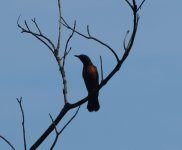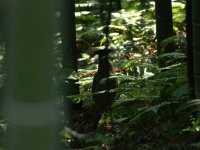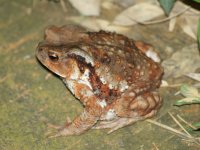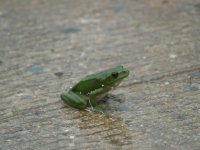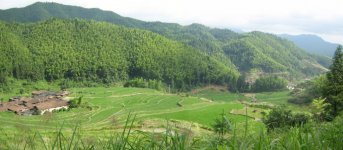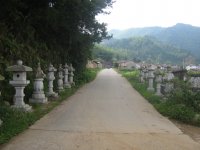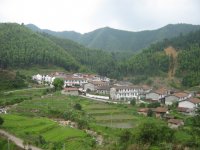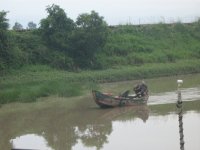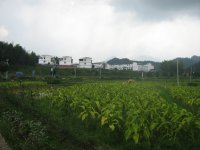Jeff Hopkins
Just another...observer

I had an opportunity to add a couple of days birding to a business trip in China. This time I chose to head to Fujian, in part to try again for the Chinese crested tern which I’d missed a few years before and also to head to the mountains at Emeifeng to look for “chickens.” I hooked up with Forest Lin who I’d birded with before. He arranged all of the accommodation and did all the driving and guiding.
Of course, the end of June isn’t the best time for birding in southern China, since many of the birds have stopped singing (or do so very early in the day and stop), the trees are not flowering anymore, and it can be a bit rainy, but the timing was not under my control. As it turned out, it was a good trip, with good birds, but a few misses, too.
Day 1 – June 24, 2014
My flight from Shanghai Pudong to Fuzhou was on time – a real surprise for China! Forest met me just outside baggage claim and we were off. My original plan was to go to the Min Jiang estuary to look for the tern on that first day, but Forest said that the tides weren’t right, so we were heading to Fuzhou Forest Park on the first day, and we would try for the tern the next day.
By the time we arrived at the park it was raining a bit. According to Forest it had been raining fairly heavily for the past few days, and judging by the streams that we had to cross, I didn’t doubt it! I found the first oriental turtle doves of the trip on the way to the parking area, and a couple red-billed blue magpies in the parking lot. We walked up a very slippery path paved with large smooth stones for quite a distance past a couple of small pavilions, to a hillside where white necklaced partridge was possible. We checked that area a bit and heard a chestnut-winged cuckoo before the skies opened up, so we walked back to the nearest pavilion to get out of the rain.
While waiting there we had a brief look at a Huet’s fulvetta* and a couple streak-breasted scimitar-babblers*, and heard a fork-tailed sunbird, but with the weather, the birds were mostly quiet and no raptors were soaring. So after the rain let up, we continued down the rest of the loop path where we found the first of several slaty-backed forktails* along the swollen creek. After about a half-hour walk and several ankle-deep stream crossings, we were back at the car. There was a great barbet calling there, but we were already pretty soggy, so we decided not to try to find it in the rain.
We found a couple spotted doves on the way out, then made a quick stop for some noodle soup at a restaurant in town, where we had our first barn swallows of the trip – they’re quite common in Fujian. Then we headed to our hotel in the Jinfeng district of Changle City and called it an early night.
Bird of the day: Slaty-backed forktail
Day 2 – June 25, 2015
I was up early and found an oriental magpie-robin singing outside my window along with the more urban species: Eurasian tree sparrows, light-vented bulbuls, barn swallows, and quite a few flocks of feral rock pigeons.
Forest and I met up at 7 AM because an early start wasn’t necessary for high tide. We stopped at some fields on the way to the estuary and picked up some of the common rural birds – cattle egret, little egret, Chinese pond-heron, black-collared starling, and crested mynah. Then we headed to our boat. After a quick ride through the marsh, with a greater coucal seen, we arrived at the duck farm at the estuary spooking a hoopoe as we climbed to our observation perch.
We scanned what little of the mudflats was above water and while we didn’t have any terns, we found a couple Kentish plovers, a few far-eastern curlews and a great egret among the more expected egrets along with hundreds (thousands?) of domestic ducks, but no terns yet. A couple of oriental greenfinches flew by while we waited. We eventually heard then saw our first great crested terns fly past, so we wandered around the corner to see where they were heading and what else might be around.
We eventually found a mass of shorebirds – mostly lesser sandplovers with a few greater sandplovers and Kentish plovers mixed in. I picked out a common redshank. There were also a few black-tailed gulls, a few hundred little terns, and ten eastern spot-billed ducks with the roosting great crested terns. Oriental reed warblers were everywhere in the marsh grasses, with a few zitting cisticolas and yellow-bellied prinias adding their songs. Eventually the tide came in and the terns moved to their more expected roost so we moved back there.
High tide came and went. The curlews were joined by a lone whimbrel. A yellow bittern flew across the mud into the reeds. Eventually we walked out onto the now-exposed mudflats to get a closer look at the terns that were there. We waited for a couple hours as more great crested terns came in along with some black-bellied plovers and a sanderling joined the sandplovers, but and still no star tern, By about one PM I was getting totally cooked, so I suggested to Forest that we give up and head for the mountains. He reluctantly agreed.
After a half-hour slog through the (sometimes shin-deep) mud, we eventually came to a dike between the fish farms. Forest left me to rest in the shade, went to get the car, and after a half-hour he returned. We made a quick stop at the hotel to wash up and check out, then began the 5 hour drive to Emeifeng. With a stop in Taining for dinner, we arrived at the Emeifeng Forest Home at the top of the mountain at about 9 PM. It was misty and foggy. We checked into our cabin and collapsed.
Bird of the day: No show
Of course, the end of June isn’t the best time for birding in southern China, since many of the birds have stopped singing (or do so very early in the day and stop), the trees are not flowering anymore, and it can be a bit rainy, but the timing was not under my control. As it turned out, it was a good trip, with good birds, but a few misses, too.
Day 1 – June 24, 2014
My flight from Shanghai Pudong to Fuzhou was on time – a real surprise for China! Forest met me just outside baggage claim and we were off. My original plan was to go to the Min Jiang estuary to look for the tern on that first day, but Forest said that the tides weren’t right, so we were heading to Fuzhou Forest Park on the first day, and we would try for the tern the next day.
By the time we arrived at the park it was raining a bit. According to Forest it had been raining fairly heavily for the past few days, and judging by the streams that we had to cross, I didn’t doubt it! I found the first oriental turtle doves of the trip on the way to the parking area, and a couple red-billed blue magpies in the parking lot. We walked up a very slippery path paved with large smooth stones for quite a distance past a couple of small pavilions, to a hillside where white necklaced partridge was possible. We checked that area a bit and heard a chestnut-winged cuckoo before the skies opened up, so we walked back to the nearest pavilion to get out of the rain.
While waiting there we had a brief look at a Huet’s fulvetta* and a couple streak-breasted scimitar-babblers*, and heard a fork-tailed sunbird, but with the weather, the birds were mostly quiet and no raptors were soaring. So after the rain let up, we continued down the rest of the loop path where we found the first of several slaty-backed forktails* along the swollen creek. After about a half-hour walk and several ankle-deep stream crossings, we were back at the car. There was a great barbet calling there, but we were already pretty soggy, so we decided not to try to find it in the rain.
We found a couple spotted doves on the way out, then made a quick stop for some noodle soup at a restaurant in town, where we had our first barn swallows of the trip – they’re quite common in Fujian. Then we headed to our hotel in the Jinfeng district of Changle City and called it an early night.
Bird of the day: Slaty-backed forktail
Day 2 – June 25, 2015
I was up early and found an oriental magpie-robin singing outside my window along with the more urban species: Eurasian tree sparrows, light-vented bulbuls, barn swallows, and quite a few flocks of feral rock pigeons.
Forest and I met up at 7 AM because an early start wasn’t necessary for high tide. We stopped at some fields on the way to the estuary and picked up some of the common rural birds – cattle egret, little egret, Chinese pond-heron, black-collared starling, and crested mynah. Then we headed to our boat. After a quick ride through the marsh, with a greater coucal seen, we arrived at the duck farm at the estuary spooking a hoopoe as we climbed to our observation perch.
We scanned what little of the mudflats was above water and while we didn’t have any terns, we found a couple Kentish plovers, a few far-eastern curlews and a great egret among the more expected egrets along with hundreds (thousands?) of domestic ducks, but no terns yet. A couple of oriental greenfinches flew by while we waited. We eventually heard then saw our first great crested terns fly past, so we wandered around the corner to see where they were heading and what else might be around.
We eventually found a mass of shorebirds – mostly lesser sandplovers with a few greater sandplovers and Kentish plovers mixed in. I picked out a common redshank. There were also a few black-tailed gulls, a few hundred little terns, and ten eastern spot-billed ducks with the roosting great crested terns. Oriental reed warblers were everywhere in the marsh grasses, with a few zitting cisticolas and yellow-bellied prinias adding their songs. Eventually the tide came in and the terns moved to their more expected roost so we moved back there.
High tide came and went. The curlews were joined by a lone whimbrel. A yellow bittern flew across the mud into the reeds. Eventually we walked out onto the now-exposed mudflats to get a closer look at the terns that were there. We waited for a couple hours as more great crested terns came in along with some black-bellied plovers and a sanderling joined the sandplovers, but and still no star tern, By about one PM I was getting totally cooked, so I suggested to Forest that we give up and head for the mountains. He reluctantly agreed.
After a half-hour slog through the (sometimes shin-deep) mud, we eventually came to a dike between the fish farms. Forest left me to rest in the shade, went to get the car, and after a half-hour he returned. We made a quick stop at the hotel to wash up and check out, then began the 5 hour drive to Emeifeng. With a stop in Taining for dinner, we arrived at the Emeifeng Forest Home at the top of the mountain at about 9 PM. It was misty and foggy. We checked into our cabin and collapsed.
Bird of the day: No show
Last edited:




